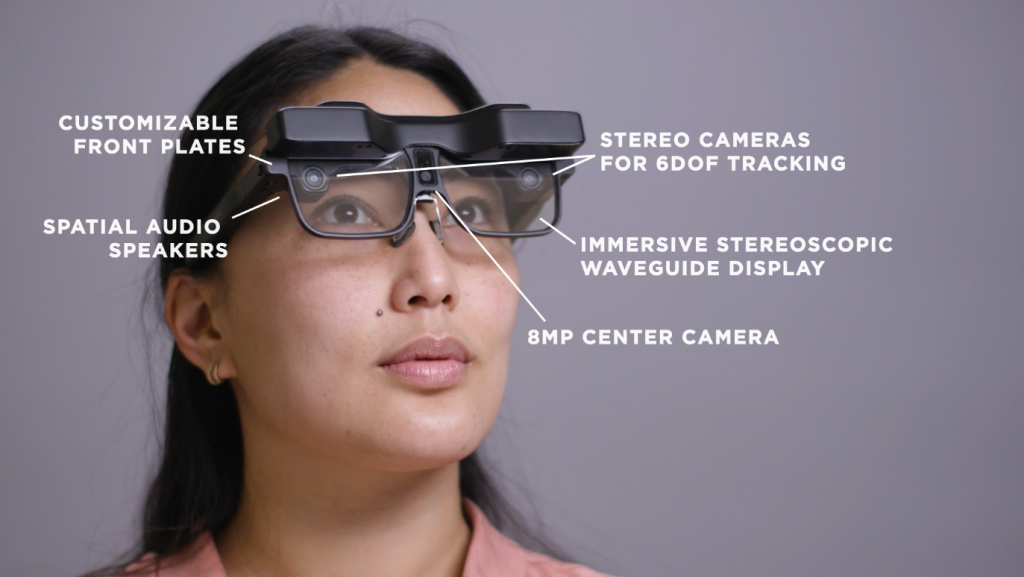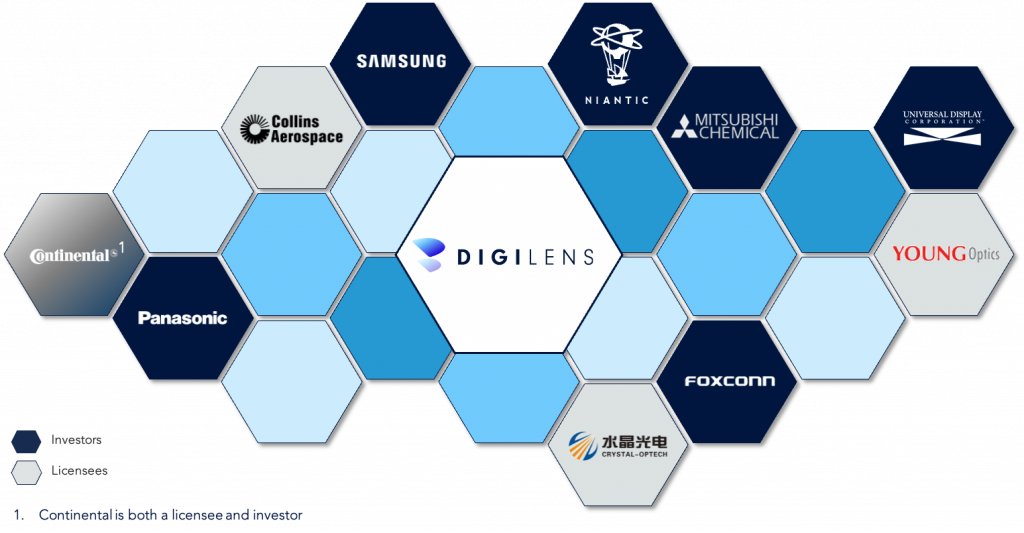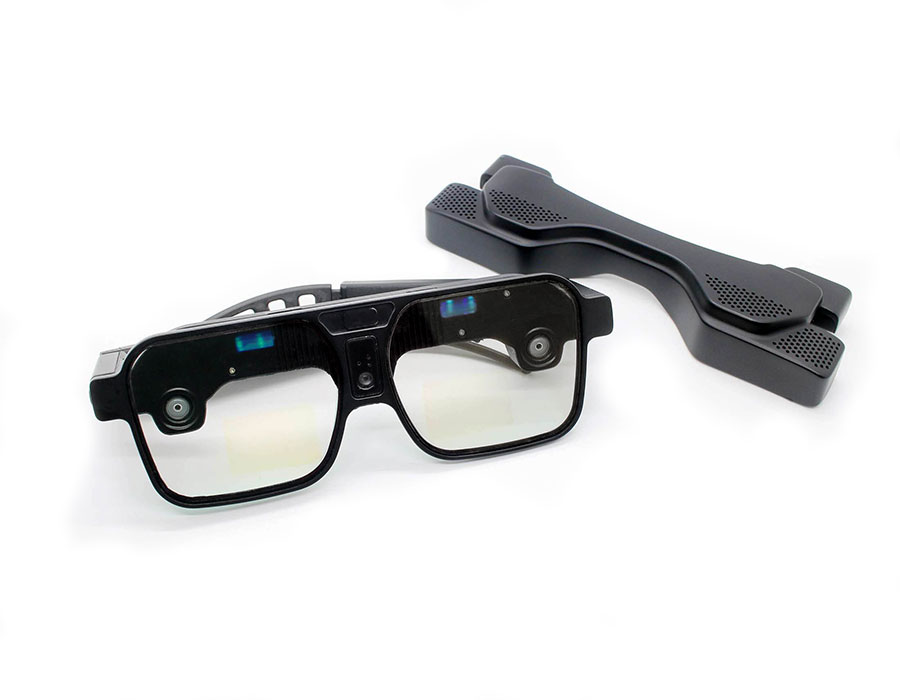June 16, 2021
Building a State-of-the-Art
Head Worn Company
Driving a horizontal business model to bring the experts of the industry together.
By Chris Pickett
We are on the verge of an upsurge of extended reality (XR) experiences as we await the first killer augmented or mixed reality (AR/MR) hardware platform to hit the mass market. While many are holding out for Apple – either scared of missing the train, or worse still, being run over by it – I believe that the Apple walled garden approach to breakthrough XR development cannot be the only line of progress nor the ultimate formula for success in this young and dynamic new category that’s being created at an ever more rapid rate.
There is general agreement that spatial computing and XR is set to be the next mobile computing platform. How and when we get there begs more questions. DigiLens is uniquely set-up for success in this emerging head worn XR market, following a long period of fundamental optics work, materials development, and process refinement. In this piece I’ll attempt to summarize where I think the industry is and tackle what the gating issues are from my perspective and from my fortunate position of working in the trenches with many of the leading industry players.
THE DIGILENS VALUE PROPOSITION
As the last decade has taught us, optics are hard but XR hardware cannot work without them – whether as heads-up displays (HUDs) in cars or as head worn devices on your face. They are your window into the XR world and DigiLens’ patented core technologies hold the key to unlocking most of these foundational breakthrough XR experiences.
DigiLens makes the core optical technologies that will deliver XR to early users in the consumer and enterprise markets. Our holographic waveguide platform will accelerate the development of more hardware options and software content for B2C, B2B, and B2G end users. We believe that DigiLens is on the path to become the de-facto optical standard for XR experiences as we provide the right balance of quality, cost, and manufacturability of XR solutions. Our proprietary photopolymer and holographic contact copy manufacturing process is more cost-effective and scalable than other waveguide solutions on the market, enabling lighter, thinner, brighter, and more efficient lenses that can be packaged in a smaller form factor.
XR is about augmenting the person. DigiLens’ vision is to allow people to perceive the world in a way that brings them material and personal value. We see a future where XR computing brings cultures together, allows people to understand the world in any language, learn new skills, or gain expertise in a trade, all within a fraction of the time it previously took.

using the Qualcomm® Snapdragon™ XR2 Platform
In other words, we’re working to break down barriers and increase productivity, which will lead to a higher standard of living for everyone, anywhere.
However, right now our audience is not the end user. At DigiLens, rather than trying to be the XR product you buy, we are instead looking to be in every XR product or experience you buy – the key ingredient that helps you perceive the world differently at a price point that makes sense for consumers. To help us get there, we need to foster and support the whole ecosystem.
MY JOURNEY
Before we dive into that, let’s take a step back into what brought me to DigiLens, where I felt I could instigate change to help push the industry forward, and ultimately why I am confident I can lead this company into its next stage of growth.

My professional background is as an Electrical Engineer. After a little time, I studied law and became an attorney. I began my start up career at Tessera Technologies (now Xperi) and eventually rose to become the EVP of Licensing and Sales. When I started at Tessera in 1994, the company changed its business model from direct manufacturing to technology licensing in the area of chip scale packaging. During my 13 years there, we licensed billions of shipments of our technologies in mobile devices, DRAM, etc. DigiLens is my fourth startup and foray in the tech world, having been CEO of Pelican Imaging and President at Global Lighting Technologies before that.
In each of these companies, I’ve been able to apply my knowledge and engineering background with my experience in licensing to create high growth models at scale that can only be achieved by enabling an entire ecosystem. This has proven invaluable in my past lives and will prove critical for DigiLens’ model of growth as it is now emerging.
REFOCUSING THE COMPANY AND ESTABLISHING TRUST
When I came in as CEO four years ago, DigiLens had aspirations of creating an optical platform that was available through multiple manufacturers. To do that, we first needed to foster an ecosystem approach that was able to scale – a group of materials providers, manufacturers, OEMs, and software experience providers.
Secondly – we needed money! In startup companies, you can never have enough money, especially when you’re working in a category that’s just beginning to be created. But that money had to be from the right places and would take time. Our investors and strategic partners were carefully chosen and are all at the top of their game. These include:
- Niantic Labs, the #1 AR software company;
- Samsung Ventures representing the #1 mobile device company and the leading electronics company;
- Sony Innovation Fund representing a leading electronics company and game console company;
- Mitsubishi Chemical Holdings Corporation representing the #1 plastics company for glasses applications;
- Continental AG the #1 automotive heads-up display (HUD) manufacturer; and
- UDC Ventures the #1 OLED technology licensing company
Combined with our visionary early investors, these corporate allies create a powerhouse of brands that are the cornerstone of our platform, and they provide confidence to our customers that our waveguides have the best combination of performance and cost effectiveness in the world.
Also, they are partners that have an amazing reputation and gravity to attract the right talent to help you get to where you need to go and to help build stellar relationships with those brands at the top of the funnel. Building strong customer relationships is key and something that we are hugely proud of today.
Building for an emerging market always takes longer than you think. As we’ve seen time and time again across the industry – over promising and under delivering has been the downfall of a series of fundamentally great companies. Being realistic about the time something will take and staying true to the reality of the current market has been vital for DigiLens in building trust with our OEM and ODM partners.
In the face of XR market hyperbole, I continue to guide the DigiLens team to under promise and over deliver. DigiLens is working to create a sustainable business model, one that will be financially successful for us and for our partners.

THE IMPORTANCE OF THE ECOSYSTEM
Today, the XR market is at an inflection point, on the cusp of huge growth. But it needs the support of the whole ecosystem to realize its full potential. As with any new market, there are many components that play into this value chain.
At DigiLens we recognize that the fastest way to bring XR hardware and experiences to the consumer is to offer a framework for partners and enable the value chain from the bottom up. We are not trying to be vertically integrated, but rather create scalable industry alliances to bring the best possible solution to market as quickly as feasible. We empower our partners to iterate and innovate as fast as their internal processes allow.
So, how do we create and foster ecosystem scalability for our waveguide optics? We start with being world class at designing and manufacturing waveguide displays – and then also being world class at transferring that knowledge to other manufacturers so they can make waveguides themselves. The next step is to partner with our strategic investors and customers to add fundamental materials expertise, business model expertise, end device and markets understanding with software experience understanding.
Prior to this second step, it’s important to have an industry leading optics technology that is highly differentiable. DigiLens has created its own suite of design and modeling software, proprietary photopolymer material sets, and a high yielding contact copy process. This combination sets DigiLens apart because we can iterate on waveguide designs more quickly than our competition and we can offer unique waveguide features that are not available from others. Let me provide a few examples that demonstrate my point:
- Efficiency: At the beginning of 2020 when the company announced its first configuration of the Crystal50 waveguide, we were achieving around 10 nits/lumen averaged across the entire field-of-view (FOV). Today, because the team was disciplined and focused on executing within DigiLens’ design system, I can share that the same configuration of the Crystal50 waveguide is repeatably producing 400 nits/lumen averaged over the entire FOV. This is by far the most efficient diffractive waveguide in the world, which allows for smaller batteries and sleeker glasses form factors.
- Switchable Gratings: At the same time, while working with several customers, we have shown our gratings can switch on-and-off at a rapid pace allowing us to stack the gratings at the input of a waveguide and effectively double the resolution of the inputted light engine. DigiLens has the only technology that can add this feature without adding volume, weight or a large power signature.
- Plastic: Our photopolymer and contact copy process allows us to use plastic substrates, further reducing cost and weight while adding safety. We will soon be announcing key breakthroughs with our partner and early investor Mitsubishi Chemical – the dream company to partner with for plastic lenses!
With this combination of waveguide features, it is realistic to expect compelling outdoor use cases to be built with head worn devices that aren’t heavy monstrosities or devices tethered to the user’s head. What’s more is that, because of DigiLens’ licensing business model, our production partners can update their manufacturing lines and begin to produce tailored waveguides in volume for their (our) customers. I’m very excited about this, because this means as an industry, we have reached the point where consumer electronic companies can begin the process of integrating DigiLens’ waveguides into their future products.
I think it is important to highlight that our production partners allow us to scale quickly with the demand at an attractive price point and play with the big boys. Big tech players need to have qualified volume suppliers for critical components. If we supply waveguides through and with those companies – the ODMs and the OEMs – we are enabling access across the market and helping those next up in the chain to progress the XR market as fast and effectively as possible.
LEADING FROM WITHIN
We often hear from big tech companies that they don’t know what future XR devices will look like. Because of this reality, we define an iteration of tech for them that will be of value and will lead their thinking.
DigiLens’ core technology offerings are the key internal components that will allow for sleek see-through digital overlays at a consumer price point and form factor, being small enough to fit into a pair of glasses or within the next generation of automotive dashboards. We’re democratizing the accessibility of the state-of-the-art optical solutions so the industry can reach a viable pair of XR glasses sooner, tipping the balance of XR computing from the enterprise to the mass consumer within the next three years, and we’re doing it in a manner that allows for the largest number of companies to benefit.
To help our partners and OEMs accelerate their internal head worn activities, I had the team create a hardware development process we call the Visualize Framework. Visualize’s purpose is to allow companies to capitalize on all of DigiLens’ expertise in optics, photopolymer materials, and head worn ergonomics to effectively innovate through iteration in a streamline collaborative process. This provides optionality for companies to white label smartglasses, to iterate on the light engine, the design form factor, or some other key aspect of the hardware. It also allows software partners to learn how to optimize their unique UI/UX interfaces with this next wearable computing platform in a manner that is done quickly and behind the scenes. This will help foster industry standards quicker than if things continue along the current status quo path and allow for less friction between different XR companies and solution providers.

WHAT’S NEXT?
The enormity of the change from mobile phones to XR head worn should not be understated. It’s why Facebook, Apple, Google, Snap, Microsoft, and pretty much all the rest of the landscape of mobile companies and app providers are each annually investing huge amounts to try and create their own platforms. XR computing will fundamentally change how we view the world in a way that’s relevant and personal to each individual. It will redesign the mobile platform as we know it. People will interact with their digital experiences in fundamentally different ways. The potential of this shift is massive.
DigiLens recognizes that we are just one part of the solution, albeit an important one, that will make this a reality, and rather than trying to do it all and falling short, we’re going to work with and rely on our network of partners who are the best in the business, to collaborate and create the best, end-to-end solution there is available on the market. You can be assured that I’m going to continue to push to make this happen – at speed and scale.
More work still needs to be done. More announcements are coming. But I can promise you that you’re going to want to see what comes next, as we’re just starting to hit our stride, and I’d like to invite you to come and join us on this exciting journey.
Legal Information and Disclosures
This thought piece expresses the views of the author(s) as of the date indicated and such views are subject to change without notice. DigiLens has no duty or obligation to update the information contained herein. Further, DigiLens makes no representation, and it should not be assumed, that the head worn hardware market will develop in a manner envisioned by DigiLens.
This thought piece is being made available for educational purposes only and should not be used for any other purpose. The information contained herein does not constitute and should not be construed as an offering of advisory services. Certain information contained herein concerning trends and performance is based on or derived from information provided by independent third-party sources. Digilens, Inc. (“DigiLens”) believes that the sources from which such information has been obtained are reliable; however, it cannot guarantee the accuracy of such information and has not independently verified the accuracy or completeness of such information or the assumptions on which such information is based.